NORD STREAM 2
Pipeline Project Delivers Science with Energy
(Updated October 2021)
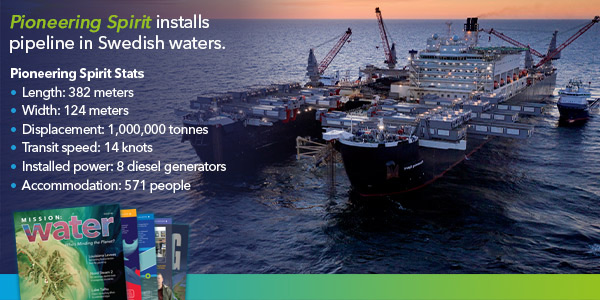
Pioneering Spirit, the world's largest heavy lift and pipelay vessel, is shown here at work in the Swedish Exclusive Economic Zone. The smaller ship to the right is among the fleet of supply vessels that make deliveries to the floating factory on a round-the-clock schedule. February 26th, 2019 © Nord Stream 2 / Axel Schmidt
Building the Nord Stream 2 pipeline across the Baltic Sea is no small project.
Of course, it's a challenge to lay approximately 1,230 kilometers (764 miles) of 48-inch (1.2-meter) twin pipeline across Europe's storm-tossed northern waters, a process that began in the middle of 2018.
There's the logistical task of coordinating the $8-billion capital investment and the hundreds of companies involved in the construction, and the political challenge of balancing the demands of the five countries whose borders will be crossed by the pipeline.
Then there is the intense environmental scrutiny as every 12-meter (39-foot) segment is welded to the pipeline and lowered into the sensitive environment beneath the waves.
In short, the world is watching the Nord Stream 2 project. Watching and listening. And as the pipeline construction team cruises through the Gulf of Finland laying three kilometers (1.9 miles) of pipeline per day, the extensive water monitoring system developed by Finland's Luode Consulting is the eyes and ears for the pipeline company, European regulators, and scientists across the globe.
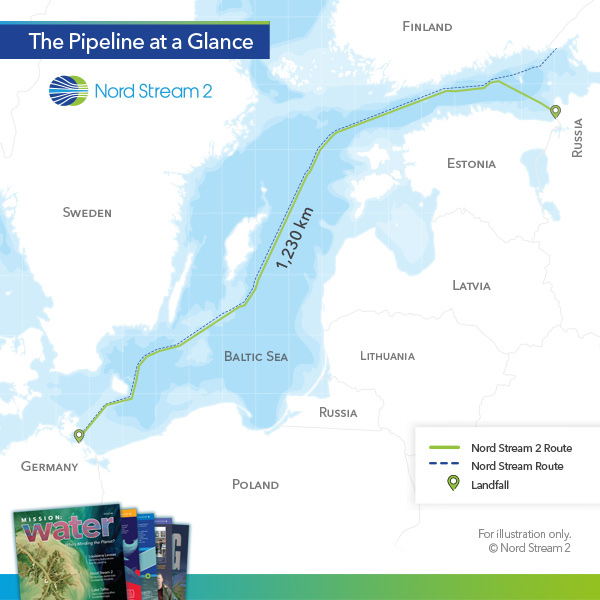
For illustration only
© Nord Stream 2
Carefully Routed
In 1998, the Russian government's gas company, Gazprom, and Finland-based energy company Fortum charted the initial course of the current pipeline in operation, simply called Nord Stream.
At the time, engineers and scientists screened 2,500 km2 (965 mi2) of possible routes to connect the gas fields of Russia to consumers in Europe. They determined that the best route cut through the Baltic Sea and Gulf of Finland.
The underwater approach is less costly than building onshore, because the speed of construction is quicker. Underwater pipelines can also be operated at much higher pressure than terrestrial ones—as much as 220 bar (224 kilogram/cm2 or 3,191 psi)—which allows the system to operate with no need for interim compression, lowering greenhouse gas emissions.
The underwater plan also allowed the pipeline company to avoid laying pipe across villages, cities, homes, fields and cultural heritage sites.
But the Nord Stream route, which also defined a path for the current Nord Stream 2 project that recently began construction, runs close to protected sites set aside for seal habitat. It also crosses through old minefields.
Those special considerations, along with more typical pressure to minimize harm to water quality from construction, mean the Nord Stream 2 water monitoring program is held to an extremely high standard.
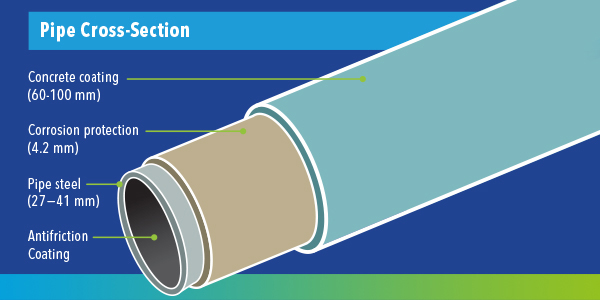
Huge Pipeline, Huge Logistics
Laying approximately 1,230 kilometers (764 miles) of a twin pipeline is a huge feat: the materials alone weigh 4.7 million metric tons. But as the European Union shifts its energy consumption toward natural gas to replace other non-renewable fuels—and to bridge the trough when solar and wind energy is lagging—the need to fill Europe's gas deficit has made the project worth the effort.
Nord Stream 2 is constructing a pipeline across the Baltic Sea to connect the gas fields of northern Russia—home to about 15 percent of the world's gas reserves—to European buyers. To build the project, the pipeline company has created a green logistics concept around four hubs that make the supply chain as short as possible.
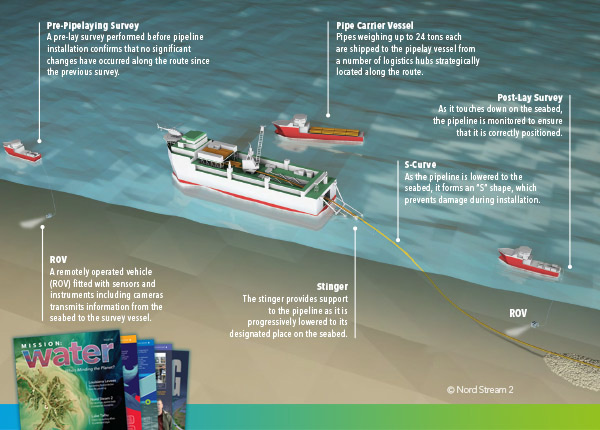
According to the company, €150 million ($172 million) worth of supplies for the pipeline have been sourced in the Baltic Sea region, and more than 90 percent of the supplies have been transported by ship or rail to minimize greenhouse gas emissions.
Pipe joints are manufactured in Germany and Russia in 12-meter lengths and delivered to logistics centers in Kotka, Finland, and Mukran, Germany, to be coated with concrete, which doubles their weight from 12 metric tons to 24 metric tons.

About half of the coated pipes are then transported to Karlshamn, Sweden, and Hanko, Finland, so they are staged along the construction route.
From the hubs, about 300 coated pipes are delivered daily to the pipelay vessels, where sections are welded one by one to the pipeline and laid on the seabed. By late 2019, Nord Stream 2 will begin delivering gas for electrical plants and home heating to customers in Belgium, the Czech Republic, Denmark, France, Germany, the Netherlands, the United Kingdom and other countries.
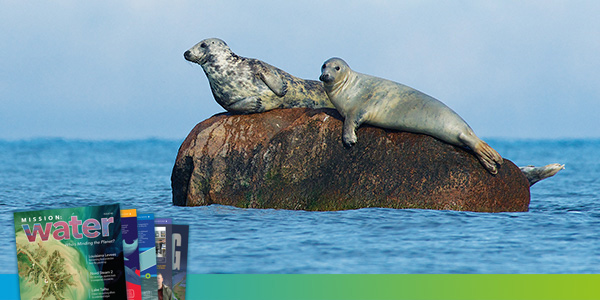
Reducing the environmental impacts on marine life, like this pair of Baltic Gray Seals, is a top priority of the project.
Regulation & Policy
"Environmental monitoring will take place before construction, during specific construction activities and after the pipeline is completed," explains Tore Granskog, permitting manager, Finland, for Nord Stream 2.
"The monitoring program includes 12 receptors that collect information about abiotic, biotic and socioeconomic parameters across the five countries — Russia, Finland, Sweden, Denmark and Germany — whose waters the pipeline passes through."
Antti Lindfors of Luode Consulting notes that regulations and monitoring protocols have evolved since the first Nord Stream pipeline was laid through the Baltic between 2010 and 2012.
For example, Finland requires Nord Stream 2 to monitor underwater noise during the clearance of munitions, naval mines and unexploded aerial bombs left beneath the sea after decades of conflict in the 20th century, and during the construction of rock berms to support the pipe where it crosses the highly uneven sea bed.
Scientists and policymakers were especially concerned about the effects of underwater noise from munitions clearance on the health and behavior of seals and porpoises.
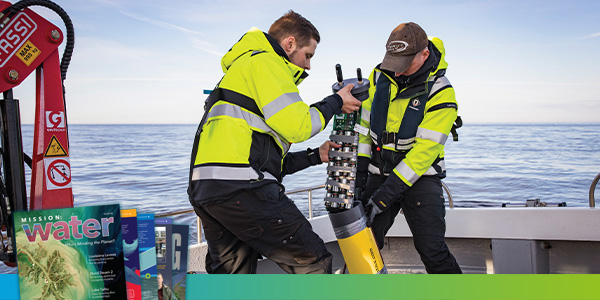
Technicians prepare a hydrophone to measure noise emissions during munitions clearance. © Nord Stream 2 / Axel Schmidt
"The monitoring program has been upgraded to meet the latest standards, and [specifically] underwater noise monitoring is added into the program," Lindfors says.
"The main concern is the seal populations in the Baltic Sea. As the Baltic Sea is still heavily populated by munitions, old sea mines and bombs from World War I and World War II, special attention was needed to ensure the safe installation and operation of the pipelines, which necessitated the clearance of munitions from the installation corridor."
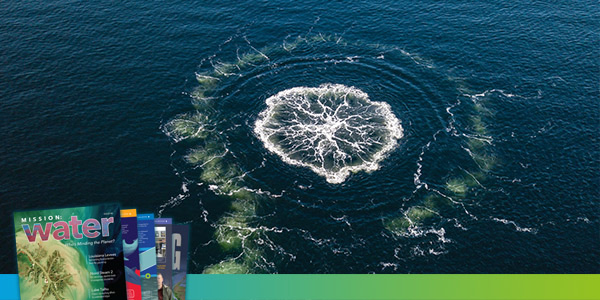
All countries along the Baltic Sea route benefit from the controlled removal or detonation of World War I & II naval mines. © Nord Stream 2 / Axel Schmidt
A Minefield
Building the massive Nord Stream and Nord Stream 2 gas pipelines through the Baltic Sea has often proven to be fraught with minefields. Not just political ones. Real ones.
During World Wars I and II and the Cold War that followed, opposing navies jostled for advantage in the Baltic. Harbors and channels were strewn with mines—estimates range from 80,000 to 150,000 of them, mainly in the Gulf of Finland—and littered with air-dropped bombs and depth charges. After the world wars, vast stockpiles of artillery shells and other ordnance were also dumped at sea.
To safely build the Nord Stream and Nord Stream 2 pipelines, explosives experts had to clear mines along the route. For the vast majority, relocation and recovery were not considered viable options, so in-situ clearance—detonation on the seabed—was employed. Some of the mines have charges as large as 300 kilograms (660 pounds), and their detonation could have significant impact on wildlife. To minimize the damage to habitat and marine life, mine clearance has come a long way since the old days of cutting anchor lines and shooting the bobbing explosives from minesweeper ships.
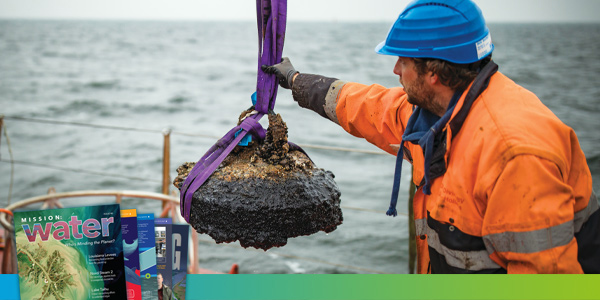
A technician inspects a find during munitions clearance operations. Nord Stream 2 conducted extensive surveys along the pipeline route to avoid unexploded ordnance (UXO)—mines, bombs and dumped munitions—whenever possible.
© Nord Stream 2 / Axel Schmidt
Nord Stream 2 performed detailed environmental assessments of the potential impact of munition clearance to establish mitigation measures to minimize the risk of permanent hearing damage to wildlife. Along the Nord Stream 2 route in the Gulf of Finland, ordnance experts used a remotely operated vehicle to identify mines and attach small explosive charges to them.
Another vessel's crew laid special hoses around most of the mines to be cleared and pumped high-pressure air to create a curtain of bubbles that absorbed most of the concussive wave energy caused by the explosion. As with every other aspect of construction, Luode Consulting of Finland was on-hand with its monitoring equipment to ensure the effectiveness of the mitigation measures to protect wildlife.

"In addition to noise monitoring underwater, we also monitor water quality in those regions because they are so sensitive—like underwater reefs where we have sensitive areas of vegetation and fish are laying eggs," says Antti Lindfors of Luode Consulting.
Hydrophones miles away from the blasts provide insight on sound waves in the water, particularly around seal reserves in Finland and Estonia.
The thorough monitoring protocol has demonstrated that the bubble curtains are highly effective at reducing noise from the explosions, and the uneven topography of the sea floor helps dampen noise and sediment disturbances, says Lindfors.
"The effects are smaller in size, and in many areas, we cannot see impacts of elevated turbidity levels higher than background variations," he notes. "The areas of dangerous noise are smaller than predicted in the Environmental Impact Assessment."
Lindfors acknowledges that the ordnance clearing by the pipeline company does not address all the legacy mine risks, but in a region where a mine anchor line is occasionally severed by drifting ice, and in an area of commercial fishing, every mine that is out of commission makes the sea's busy traffic and fishing areas safer.
"The mine clearance operation benefits the whole Baltic Sea," he says.
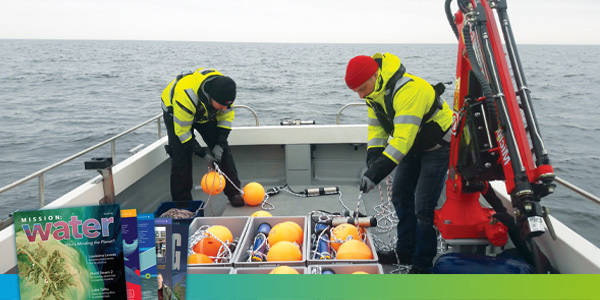
EXO sondes are carefully linked together for easy deployment, while avoiding snags and tangles. Supported by an array of flotation buoys, this chain of sensors will provide water quality data on a range of parameters critical to the success of Nord Stream 2. © Antti Lindfors / Luode
Extensive Network
Lindfors and his colleagues have positioned more than 50 YSI EXO multiparameter sondes in 15 to 17 sites along the pipeline route to continually measure turbidity, oxygen, temperature and salinity. The instruments were anchored on the sea floor, 40 to 90 meters (130 to 295 feet) beneath the surface, to keep them out of the way of traffic.
"The Baltic Sea is used very heavily for commercial shipping," Lindfors notes.
"We do everything submerged so people don't know they are there. From our point of view, it is safer."
Acoustic Doppler current profilers (ADCPs) provide data on currents throughout the water column, and grab samples enable the Luode crew to analyze sediments and benthic fauna. To meet the demands of the sound monitoring protocol, the team deploys self-logging hydrophones.
Lindfors and his partners have long experience with YSI instruments, dating back to their academic studies in the 1990s. The evolution of multiparameter sondes has been a great benefit to projects like these, he says.
"The main idea is you have 'multi-talented' sondes that all have the same body and the same software to work with," Lindfors notes. "That's the biggest benefit, and we are able to do the calibrations easily, too."
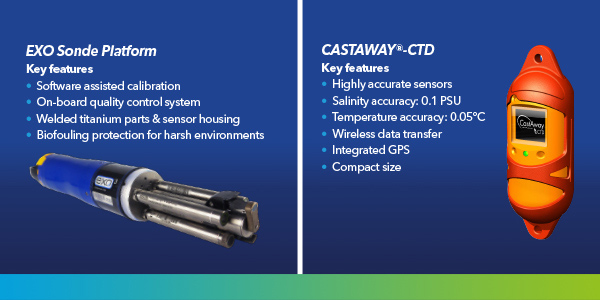
Challenging Environment
Calibrating the sensors for the EXO sondes may be easy, but the life of an instrument in the Baltic sea is anything but.
"The Baltic Sea is a brackish water basin with large vertical and horizontal gradients," Lindfors explains.
"Therefore, a selected monitoring device must be able to handle big temperature and salinity variations. In addition, a long ice-covered period brings challenges to monitoring. Systems need to run several months without maintenance, and the presence of drifting ice makes it impossible to use any telemetry systems. Therefore, monitoring is based on stand-alone sensors."
Lindfors and his team pull each EXO to the surface approximately every three months—the gap widens to four or five months when the sea is frozen over. During the quarterly visits, they download logged data and change out instruments for replacements calibrated in the
lab and equipped with fresh batteries.
At each site, they profile conductivity, temperature and salinity of the water column with two instruments, including a SonTek CastAway CTD, a baseball-sized instrument that can be quickly cast to the bottom and retrieved with a simple reel. The maintenance visits also provide a chance for the group to collect and analyze water samples for laboratory-based verifications.
Even after enduring Baltic winters, during which water temperatures can fall to -0.2° or -0.3° Celsius (31.4 Fahrenheit), the EXO sondes have a remarkable track record for delivering extensive logs of water quality data for scientists.
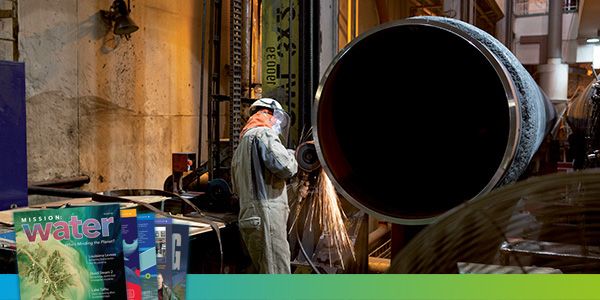
Nord Stream 2 crew members aboard the Solitaire thoroughly clean and prepare the ends of each pipe before welding to ensure a tight seal. © Nord Stream 2 / Thomas Eugster
Less Impact
Data on the effects of the first Nord Stream pipeline project indicated that munitions clearance and construction operations have had less impact than environmental impact models suggested, notes Granskog of Nord Stream 2. He says years of data from the previous effort "showed that the impacts were minor, short-term and local."
Granskog adds that because of the sensitive environment—both physical and political—surrounding the pipeline project, research must be top-notch.
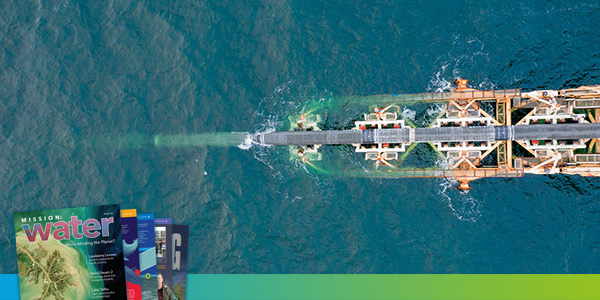
The pipeline can be seen from above as it is lowered from pipelay vessel Audacia's stinger and installed on the Baltic seafloor in German waters. © Nord Stream 2 / Axel Schmidt
"In order to understand the potential impacts of construction activities on the environment, it is of paramount importance that the data delivered are accurate both in space and time," he says.
"Correlation between the monitoring data and construction activities—of which we also have accurate information—allows the environmental experts to understand the potential connections between the construction activities and the monitored environmental parameter."
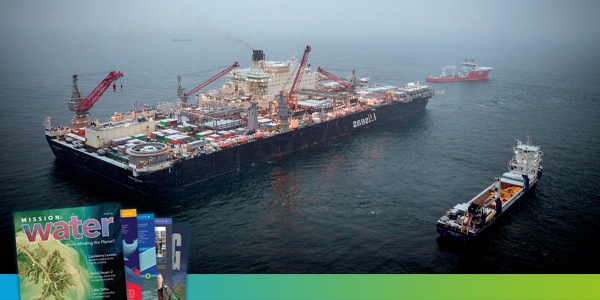
Dynamically positioned pipelay vessel Pioneering Spirit at work in the Gulf of Finland in late December 2018.
© Nord Stream 2 / Axel Schmidt
Advancing Science, History
The high quality of the Nord Stream data, which the pipeline company made freely available for research, has proved to be a benefit to the scientific community, and Granskog says plans call for data from the Nord Stream 2 project to also be shared with researchers.
After all, few projects afford scientists the opportunity to deploy 50 continuous, multi-parameter sondes in a study area, let alone back them up with extensive sea floor surveys and other data gathering tools. The scale and scope of the Nord Stream and Nord Stream 2 monitoring programs have turned out to be great not only for scrutinizing the pipeline project, but also for providing a rich trove of data on water quality in the Baltic.
That has been especially helpful in understanding oxygen dynamics in the hypoxia-prone Gulf of Finland system, Lindfors notes.
"As the Baltic Sea is very sheltered, we have limited access to the Atlantic Ocean via the shallow North Sea," he explains.
"In order to get oxygen into the Gulf of Finland, we are dependent on saltwater pulses—a huge amount of Atlantic water entering the Baltic."
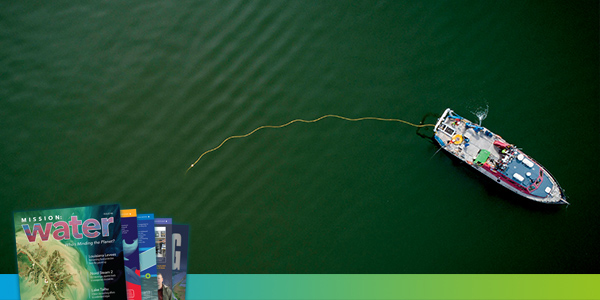
ROVs are attached to the real time survey vessel by an electrical and fibre-optic cable that allows the crew to navigate close to the seabed. The cable transports the data and images collected by the ROV along the sea floor back to the vessel, where technicians can review it in real time. © Nord Stream 2 / Axel Schmid
Just a couple of times per decade, all the factors align to create a pulse, Lindfors says. Water levels in the Baltic must be down, a zone of low atmospheric pressure has to form over the Gulf of Finland, and winds need to be oriented in the right direction. Only then can a massive flow of high-oxygen, high-salinity Atlantic water push into the isolated gulf.
Luode's network picked up a pulse during the baseline monitoring phase of the Nord Stream 2 project and was able to document the movement of the oxygenated water almost minute by minute, providing a detailed account of this remarkable phenomenon.
The pipeline company's detailed surveys of 55,000 linear kilometers (34,000 miles) of sea floor along the construction route—conducted with state-of-the-art towed-array sonar and remotely operated vehicles launched from large research vessels that most nautical historians could only dream of—have also contributed to the understanding of the history of the Baltic region.
"We found a number of previously unknown cultural heritage objects such as an 18th century merchantman and a late-18th/early-19th century cannon barge located in the Finnish Exclusive Economic Zone," says Granskog. "Two inspected World War II targets—a Havoc bomber and the anti-submarine net installation—were also listed of historical interest."
Europe is hungry for natural gas, and the Nord Stream and Nord Stream 2 pipelines are creating an important conduit for new supplies. But through their extensive water quality monitoring programs, the projects are also delivering something more—deeper understanding of a challenging and fragile environment, and a thorough documentation of the real-world impacts of undersea construction.

Additional Blog Posts of Interest
Red Tide Monitoring in the Gulf of Mexico | From Cells to Satellites
How to Overcome 5 Water Quality Monitoring Challenges
7 Tips to Fight Fouling and Extend Water Quality Sonde Deployments